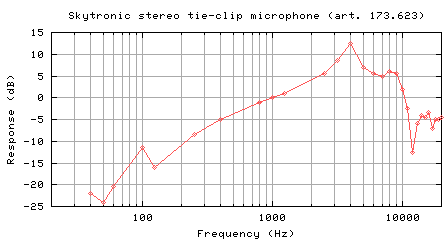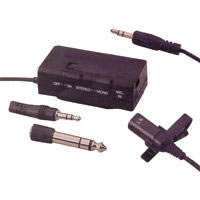173.623 (Vivanco EM216) stereo tie-clip microphone specifications
The 173.623 tie-clip stereo electret condenser microphone is quite
cheap (about EUR 36) and sold by various electronics resellers,
such as Skytronic, Tandy, Sound Lab (Soundlab, model G157B),
Vivanco EM 216, apparently only in Europe. I bought one in The Netherlands. The
supplied specifications are minimal, so I decided to measure the
frequency characteristic myself after I noticed that the basses were
really weak. So there:
Specifications according to manufacturer
| Sensitivity(*) | -68 dB (+/- 3 dB) |
| Impedance | 2000 ohm |
| Frequency range | 20-16000 Hz |
| Transducer | Twin omnidirectional electret condensor |
(*)Sensitivity is probably relative to 1V, 1 mu-bar. See
manufacturer's site.
The specified frequency range is `somewhat' exaggerated. For a reasonable
sound reproduction, the curve should be flat (within +/-3 dB) in the range
100--12000 Hz. This microphone behaves rather as a 4 dB/octave high-pass
filter with a cut-off at 2.5 kHz. Moral: never trust frequency range
specifications for microphones unless you get a curve. By the way, a
frequency response range for a microphone means nothing more than that every
individual microphone should have a response curve that differs no more than
+/-2.5 dB from the specified response curve. The latter need not be
flat.
If we convert the specifications to the more common notation, we
get:
| Sensitivity |
-48 dB (at 1 Pa, re. 1 V = 0 dB) |
| Frequency range | 500-11000 Hz |
Measurement details
The microphone was suspended at 64 cm in front of a loudspeaker in an
echo-free situation (i.e. my loudspeaker in the window and the
microphone suspended outside my apartment on the third floor). The
microphone was in mono mode, "LR" symbol towards loudspeaker, and
connected to a portable Sharp MD player and then to a mixer panel. I
used the VU meters in combination with the fader to measure the signal
level. As a reference microphone, I used a Stagg
MCO-7 large-membrane condensor microphone in omni-directional
mode, which has a reasonably flat response between 20-20000 Hz. The sound
source was a test cd with sine waves at various frequencies.
See also: microphone theory links
Recommendations
For its price, it is not too bad. Its frequency response might actually be
an advantage for its intended purpose as a lapel microphone recording
speech. However, for recording music: the stereo effect is rather weak and
the recorded sound will be colored. The human ear does a suprisingly good
job at ignoring the latter, though. If you want to record live music, with
an MD or MP3 recorder, I'd recommend to order a pair of miniature
microphones from
Sound Professionals, that
you can plug in directly into the MD player (with a plug-in-power
connector). Use cardiods if you intend to mount them on a stand, or
omnidirectionals if you will carry them. Even though their web site is
horrible, I'm happy with the mikes I bought there. (The microphone mounts
suck, though) I am not affiliated in any way to them. A
Laatste wijziging: Original fall 2003, update Feb 2005, Jun 2006
Copyright



